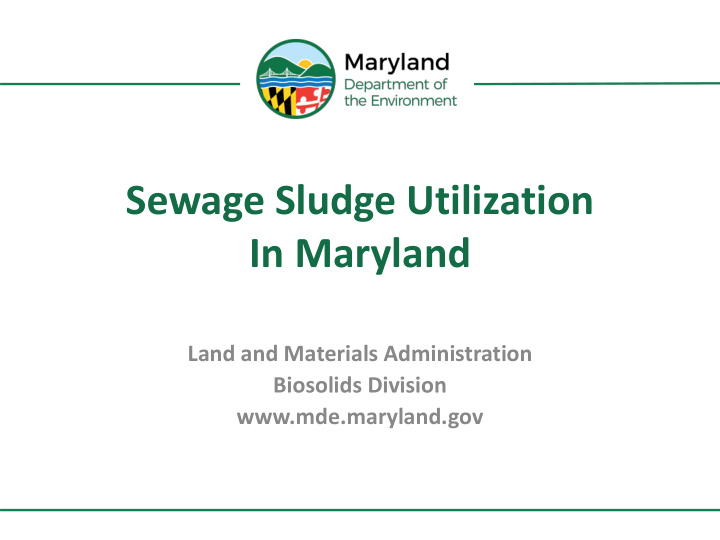



Sewage Sludge Utilization In Maryland Land and Materials Administration Biosolids Division www.mde.maryland.gov
What is Sewage Sludge? • Sewage sludge is not raw sewage. It is one of the final products of the treatment of municipal waste water at a waste water treatment plant. • After treatment breaks down the organic compounds and kills disease–causing organisms, the remaining fine particles ultimately become sewage sludge which is a nutrient-rich organic product. 2
How is it Utilized? Agricultural land application Reclamation/marginal land application Distribution Energy generation or Incineration Disposal or alternative utilization at a municipal landfill Research and Innovative projects 3
How is it Utilized? Agricultural land application • Recycles a byproduct • Returns essential nutrients to the soil – Nitrogen, phosphorus, zinc and copper • Adds organic matter to the soil • Reduces fertilizer costs to farmers • Has high water content • Can contain lime that raises the pH of soil Reclamation/marginal land application Distribution Energy generation or Incineration Disposal or alternative utilization at a municipal landfill Research or Innovative and project 4
Why & How is it Regulated? • Regulated to… – Protect public health and the environment – Protect the quality of groundwater and surface water of the State • Through… – Treatment at the WWTP – A site specific permit 5
Treatment Requirements • Sewage sludge sources are permitted for land application – Review of historical sewage sludge analysis – Review and monitoring of the treatment method – Facility inspections – On-going monitoring of nutrients, metals, and PCBs content – Record keeping and annual reporting – At a minimum, must meet Class B standards (EPA’s 40 CFR Part 503) – 37 Class B sources currently approved 6
Treatment Requirements • Pathogen Reduction – Class A – pathogens are below detectable limits – Class B – pathogens are detectable but reduced to levels that do not pose a threat to public health and the environment with proper controls • Constituent Limits – Arsenic, Cadmium, Copper, Lead, Mercury, Nickel, Selenium, Zinc, PCBs • Vector Attraction Reduction – Vectors are organisms, such as rodents and insects, that can spread disease by carrying and transferring pathogens 7
Treatment – Pathogen Reduction • Class B (3 alternatives) • Aerobic Digestion – Monitoring of Indicator Organisms • Anaerobic Digestion – • Lime Stabilization Use of PSRP (Process to Significantly • Air Drying Reduce Pathogens) • Composting – Use of a Process Equivalent to PSRP • Class A (6 alternatives) – Thermally Treated Biosolids • Composting – Biosolids Treated in a High pH-High • Heat Drying Temperature Process • Heat Treatment • Thermophilic – For Biosolids Treated in Other Processes aerobic digestion – Biosolids Treated in Unknown Processes • Beta ray or Gamma – Use of a PFRP (Process of Further Reduce ray irradiation • Pasteurization Pathogens) – Use of a Process Equivalent to PFRP 8
Treatment – Constituent Limits • Sewage sludge land applied to agricultural sites must meet constituent limits 9
Treatment – Vector Attraction Reduction 1 2 3 4 5 Use aerobic Demonstrate processes at Demonstrate Reduce the mass vector attraction Meet a specific greater than 40 ° C vector attraction of volatile solids reduction with oxygen uptake (average reduction with temperature 45 ° C) by a minimum of additional rate (SOUR) for additional aerobic for 14 days or 38 percent anaerobic aerobically digestion in a longer (e.g., during digestion in a treated biosolids bench-scale unit biosolids bench-scale unit composting) 6 7 8 9 10 Reduce moisture Incorporate Inject biosolids content of biosolids applied to Reduce moisture Add alkaline beneath the soil biosolids that do or placed on the content of materials to raise surface within a not contain land surface within biosolids with the pH under specified time, unstablized solids specified time unstabilized solids from other than periods after specified depending on the to at least 90 primary treatment application to or conditions level of pathogen percent to at least 75 placement on the treatment percent solids land surface 10
Ag Land Permit – Information Required Forms Maps Analyses Plans 11
Ag Land Permit – Site Requirements • Site Inspection • Application rates based on expected crop yield and plant-available nitrogen in sewage sludge • Slope restrictions • Buffers areas (marked with stakes or flags) • Minimum soil pH of 6.0 • Adverse weather condition restrictions • Trucks must be cleaned on site to prevent drag-out of soil or sewage sludge onto public roads 12
Ag Land Permit – Site Requirements • Following application – Signs may be required for 30 days – Animal grazing restricted for 30 days – Public access to the site must be controlled for 1 year – Crops to be eaten raw by humans restricted for 3 years 13
Ag Land Permit – General Provisions • Permit is issued for 5 years and can be renewed • Prior to land application the permittee informs – MDE – County Health Department, Environmental Health Division • Recordkeeping and reporting – Source, type and quantity of sewage sludge received and applied on each field – Soil pH – Updated NMP – Cumulative and annual constituent loading rates – Records kept on site during operations – Records sent to MDE 14
Summary • MDE’s control measures are designed to protect the public health and the environment. • There have been no known cases of disease transmission or contamination of domestic drinking water supplies in Maryland as a result of the application of sewage sludge on agricultural land. 15
Informational Websites • Maryland Department of the Environment – www.mde.maryland.gov • U.S. Environmental Protection Agency – www.epa.gov 16
Maryland Department of the Environment Land and Materials Administration Resource Management Program Biosolids Division Sewage Sludge Utilization Section Phone (410) 537-3314 Fax (410) 537-3321 1800 Washington Boulevard | Baltimore, MD 21230-1718 410-537-3000 | TTY Users: 1-800-735-2258 17 www.mde.maryland.gov
Recommend
More recommend